Just days ago, Shane Bieber was named the All-Star Game MVP. Bieber was a fitting recipient of the award, as he struck out the side in front of his home crowd at Progressive Field in Cleveland. Some were upset that Joey Gallo wasn’t awarded as the MVP, whereas some couldn’t care less. I tend to fall in the latter group, but either way, Bieber went home with a shiny MVP award and a brand new Chevy Silverado that he definitely did not need.
The interesting thing about Bieber’s breakout year is that, by some measures, he’s not all that improved. By FIP-, he’s slightly better. SIERA thinks he’s better too. By K-BB%, he’s improved substantially. xwOBA says he’s been basically the same pitcher. You get the point—there’s some disagreement! Most of the metrics like him, but Statcast doesn’t, and that’s because of the hard contact he’s allowed.
I’ve been watching Bieber from afar throughout the season, because the uptick in strikeouts piqued my interest, and I wanted to see how he would adapt to the hard contact he was giving up. Generally, if you’re missing bats, that probably means you’re also avoiding hard contact. Bieber is the exception because of the nature of his approach—it’s why Jon Gray and Nick Pivetta have made people want to pull their hair out. The thing is, things might be changing for Bieber.
If you haven’t been paying close attention, Bieber has been building up a head of steam for about a month now. The hope, of course, is that there are discernible changes that we can point at to demonstrate that, yes, Bieber is a changed pitcher! I probably wouldn’t be here if I didn’t have some confidence that he’s made significant enough changes, so here we go.
Bieber’s rolling xwOBA, per 50 PA:
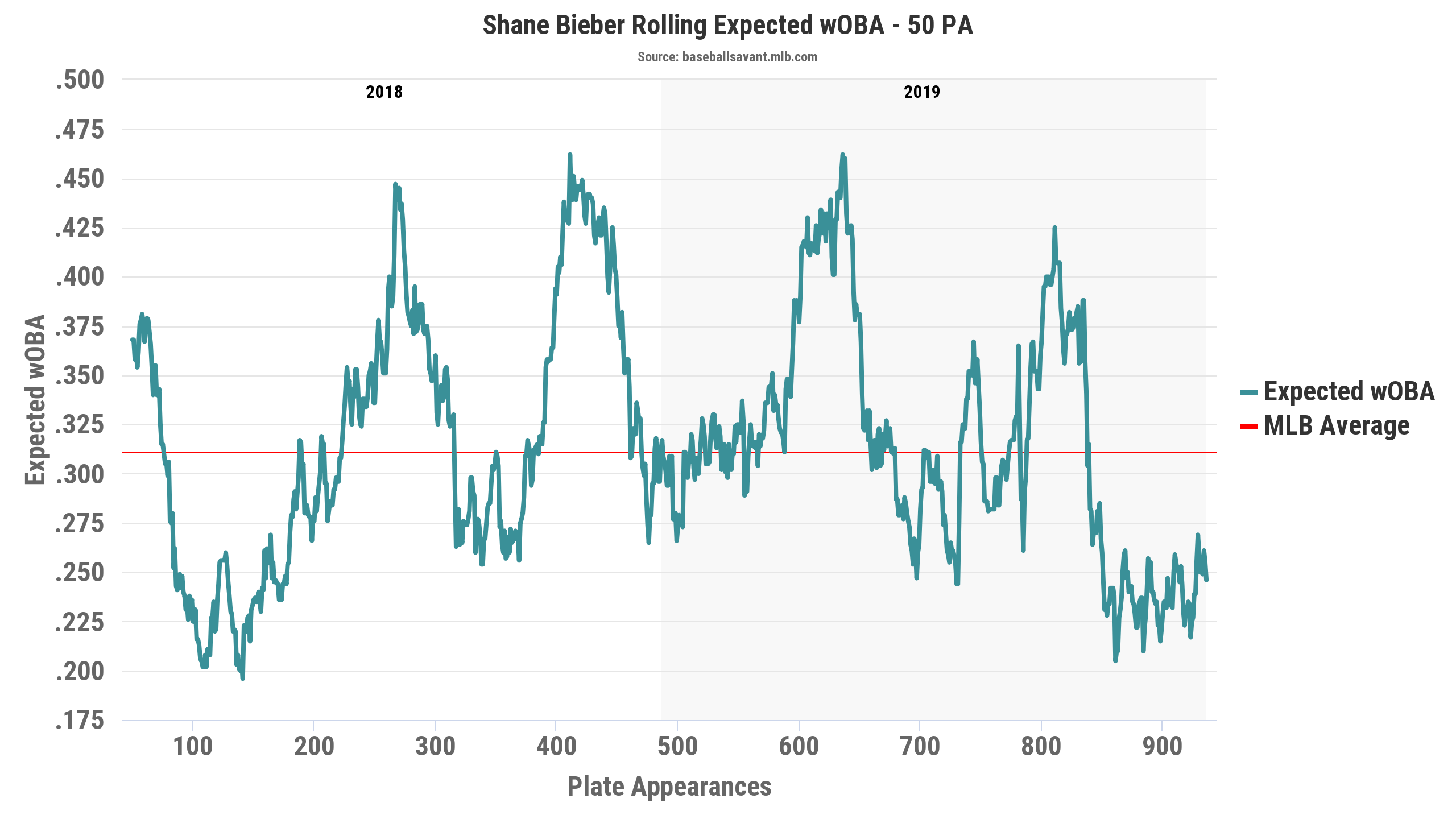
This isn’t necessarily unprecedented—Bieber has only gotten into this territory of dominance once before, but it didn’t last this long. So by xwOBA, Bieber has been elite for a month. But in looking at xwOBA, the question you have to ask is: why? Why has it improved?
Bieber’s last five games versus his first 13:
| FB% | SL% | CB% | CH% | |
| First 13 | 45.8 | 28.7 | 17.8 | 7.8 |
| Last five | 40.2 | 29.1 | 22.0 | 8.6 |
Okay, here’s a change. We’ve seen Bieber move away from his fastball in favor of his curveball, just a smidge. Here’s how all of his fastball and curveball specifically have fared:
| FIP | xwOBA | xwoBACON | K-BB% | |
| First 13, FB | 6.25 | .398 | .520 | 18.8 |
| Last five, FB | 0.84 | .242 | .364 | 33.3 |
| First 13, CB | 2.84 | .337 | .508 | 28.9 |
| Last five, CB | 0.37 | .154 | .253 | 39.1 |
In his last five starts, Bieber has been a new pitcher. He already doesn’t give up many walks, but he really hasn’t given up walks lately: In his last 35 innings, Bieber has 45 strikeouts, three walks, and one home run—that’s a 35.2 K%, 2.3 BB%, and 0.26 HR/9. This all comes with the caveat that four of his last five opponents have been pretty weak, but in fairness, he went into Arlington and dominated the Texas Rangers in June with no home runs allowed. That’s not an easy feat. And much more has happened than a mere 4% uptick in curveball usage. As a disclaimer, though, I should caution against reading into these pitch type numbers too much. I’m going to play with them, but their year-to-year reliability isn’t all that high, let alone between time periods as I’m going to look at. While the xStats are noisy, K-BB% isn’t as susceptible because it’s less convoluted in nature—that’s good for Bieber.
Courtesy of Alex Chamberlain’s amazing pitch leaderboard, Bieber’s rolling xwOBA, per 100 pitches:
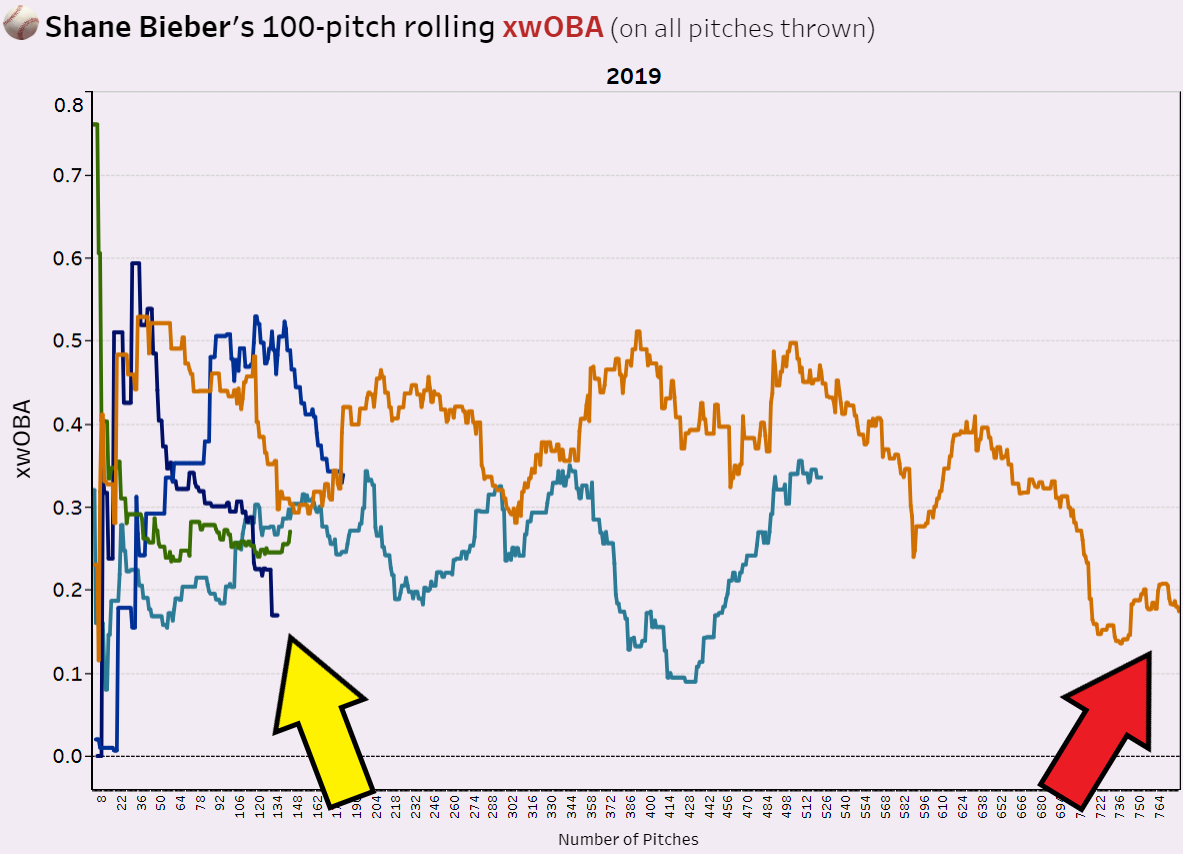
See that big, fat yellow arrow? That’s Bieber’s curveball. Lately, it’s been more dominant than ever before. There’s a bit of a problem with pitch classification (i.e., curveball versus knuckle curve), but his curveball has gotten better. As for the red arrow? That’s his fastball, which has been better than ever too.
So, okay. Usage? Check. Results? Check. What’s behind these changes?
The key, to me, is Bieber’s curveball. By game, its horizontal break:
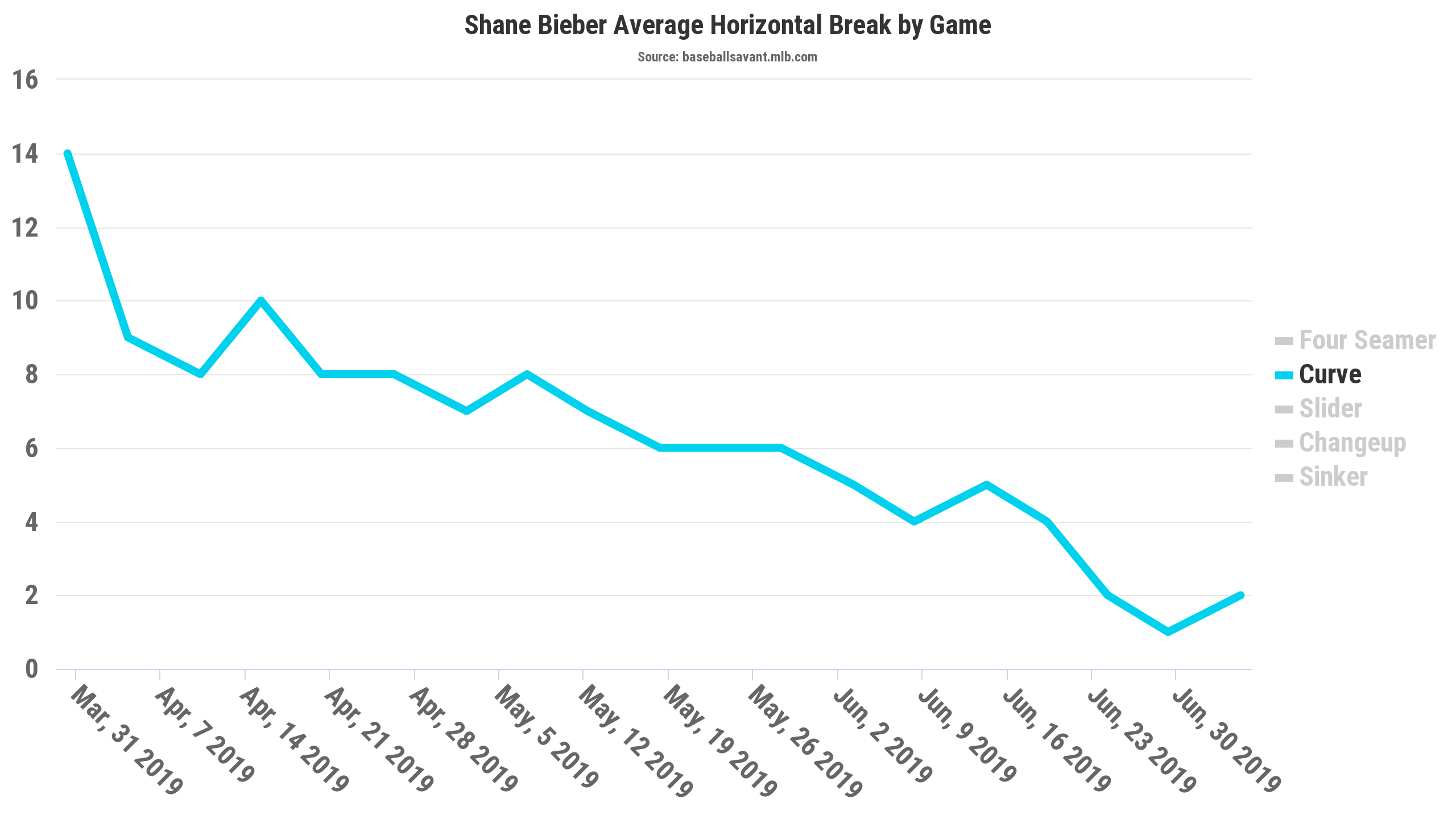
And by game, his curveball’s vertical break:
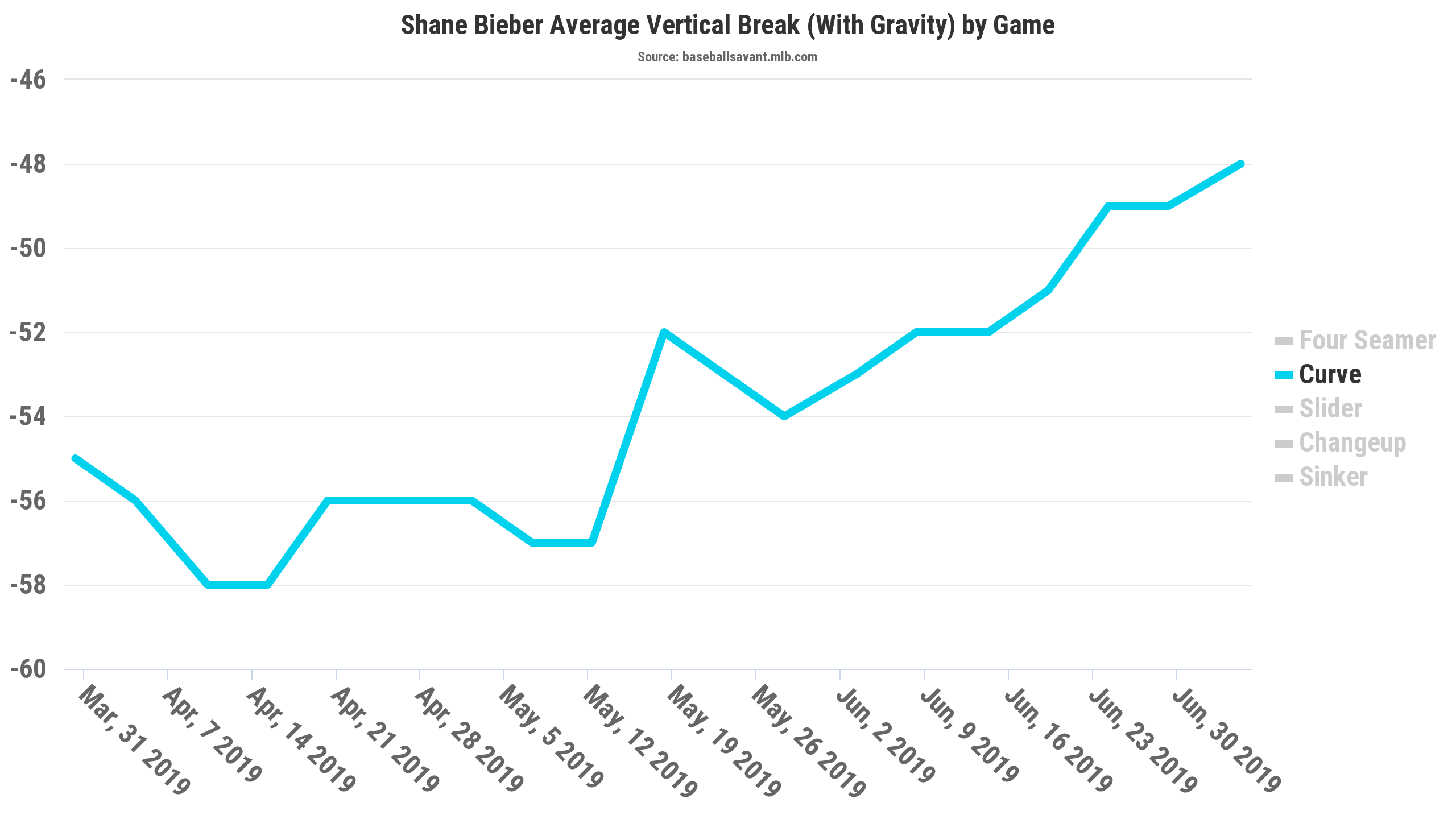
So Bieber has shaven almost all of the horizontal movement off of his curveball, but it’s also breaking nearly a foot less (with gravity) than it was at the beginning of the year. (The slider has changed its shape some too, but I think the curveball is more notable.) In April, Bieber’s curveball was in the 83rd percentile in vertical movement. In June? He’s down to the 31st percentile. The most fascinating thing is, we haven’t seen the changes in spin rate or velocity that you’d expect. In any case, in the past five games, his curveball has turned into his best pitch, results-wise. In his first 13 games, it was perhaps his worst secondary offering. In short, it’s evolving. It’s interesting that it’s been a slow, gradual change in terms of movement, but his curveball is very different from where it started the year. If I had to speculate why his fastball has suddenly become better, it seems that this coincides pretty cleanly with the unveiling of his newer curveball.
Here are the changes in movement in his pitch mix. Pay close attention to his curveball, denoted by orange triangles.
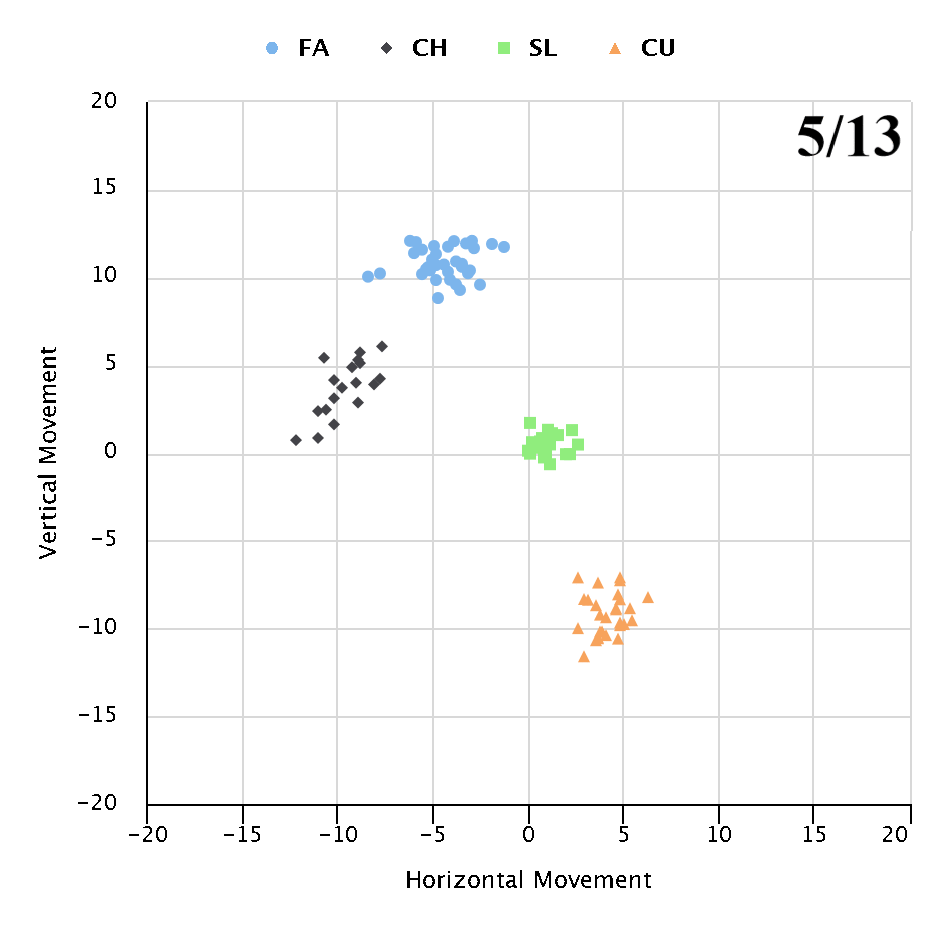
Bieber’s curveball and slider are closer than ever to true 12-6 movement. I’ve written about this multiple times now, but in this way, his curveball has become a “changeup” to his slider. As we know, a changeup is a slow version of a pitcher’s fastball. In this case, Bieber’s curveball is a slow version of his slider. It is much better mimicking his slider’s movement, and so from a pitch tunneling perspective, I have to imagine that there’s been a domino effect that has benefited all of his pitches. Keep in mind that, while retaining its velocity, Bieber has knocked something like six inches (at least) off of his vertical movement on his curveball. It’s not that his previous curveball was bad—it was fine—I think that, in part, he’s just removed superfluous movement and that his newer curveball is a better fit for him. This, in my opinion, is one pivotal change that has made Bieber so dominant for about a month or so.
For example, here is a pitch tunnel with his newer curveball:
Shane Bieber, 94mph Fastball (charitably bottom zone/called strike) and 83mph Lawn Dart Curveball, Overlay.
AKA: Why someone might swing at a 50′ Curveball.
(Or, how to take advantage of what an umpire gives you.) pic.twitter.com/tULfjmtGKB— Rob Friedman (@PitchingNinja) June 16, 2019
The thing is, Bieber could and maybe should elevate his fastball despite it not having elite velocity or spin. Bieber’s fastball whiff percentage, career:
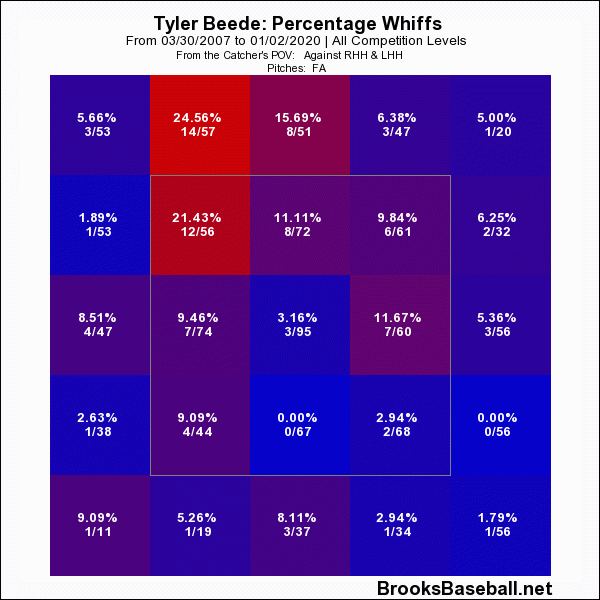
And contact percentage, over his career:
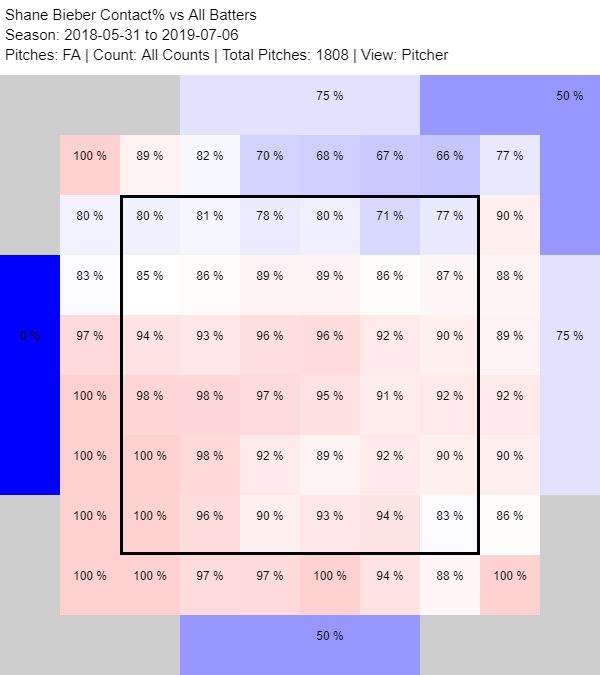
Against both lefties and righties, his fastball is best—in terms of missing bats—when he is living up in the zone. This isn’t uncommon. We’ll touch on this later, but this is something to think about for Bieber.
After all, it played a role in setting up this curveball to Ketel Marte:
All Star MVP Shane Bieber, 95mph Fastball (foul) and 84mph Knuckle Curve (swinging K), Overlay pic.twitter.com/O9UbtNjYDP
— Rob Friedman (@PitchingNinja) July 10, 2019
First Pitch
As my colleague Alex Fast has noted, hitters have been as aggressive on the first-pitch as ever.
Take a look:
% of pitches swung at in 0-0 counts:
2019: 29.1 ?
2018: 28.3 ?
2017: 28.0 ?
2016: 27.6
2015: 28.1 ?
2014: 26.6 ?
2013: 26.2 ?
2012: 25.6
2011: 25.8 ?
2010: 25.1Batters are more aggressive in 0-0 counts than they’ve been in the past 10 seasons. From an upcoming article.
— Alex Fast (@AlexFast8) June 19, 2019
Unfortunately for Bieber, he often throws first pitch fastballs for strikes, as do many other pitchers. It seems like more recently, though, he’s been attempting to combat this. Against righties, this hasn’t been an issue—Bieber is more likely to throw a first pitch slider to righties than a first pitch fastball. Against lefties, though, 58% of Bieber’s first pitches were fastballs in his first 13 games. In his past five games, his fastball has given way to his curveball, which has gone from 26% to 40% on first pitch, while his changeup has also increased from 9% to 25%. Bieber is doing his damnedest to get ahead and avoid getting punished early in the count by being predictable.
So, by pitch type, he’s become more unpredictable. By location, he’s mixing it up too.
First pitch location, first 13 games versus his last five:
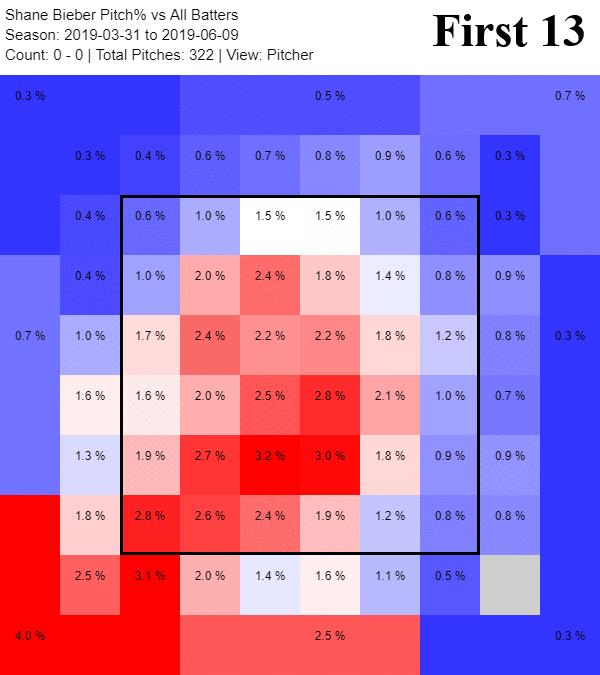
As a hitter, things have gotten more difficult. Less of the deep red means that Bieber is spreading out his pitches better—on top of mixing up his repertoire—and the deep red is mostly on the perimeter, or out of the zone, too. While the early returns have been better, they haven’t been amazing.
First pitch xwOBA, first 13 games: .546
First pitch xwOBA, last five games: .447
This is good because, on the season, Bieber ranks in the 10th percentile by xwOBA on the first pitch. If this new first pitch xwOBA were to sustain, it would bump him up to the 25th percentile. Not amazing, but better. I don’t know about you, but for now, I’ll take better.
We could also try CSW:
First pitch CSW, first 13 games: 10.3%
First pitch CSW, last five games: 12.5%
The sample is small. So, so incredibly small. But by xwOBA and CSW, he’s improved a marginal amount. This is certainly something to keep an eye on going forward, but it’s encouraging that this appears to be something that Bieber is addressing, whether deliberately or not. And to be honest—because of our limited sample—I’m much more interested in his pitch mix and location than the results thus far anyhow. This all, of course, leads us into his approach.
Approach Versus Righties
From five starts from time frame one:
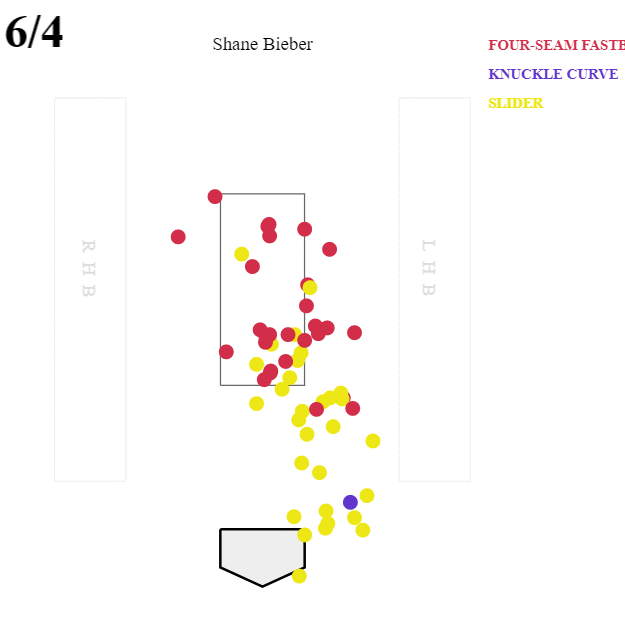
From Bieber’s most recent five starts:
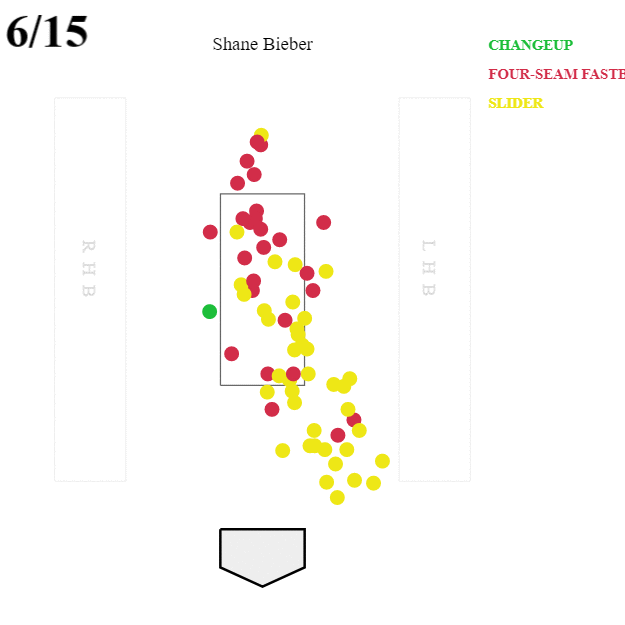
More recently, Bieber has done a better job of mostly staying away from the lower, middle of the zone with his fastball. If he is going low, it’s mostly away. He has not completely eschewed fastballs low in the zone, but compared to before, they’re few and infrequent. To me, that’s a win. Bieber has continued to pound fastballs away, but he’s also started to let them drift up towards the top of the zone—and on June 15th in particular, he was actually elevating his fastball quite a bit, which I love to see. With average fastball velocity and spin, elevating sounds ill-advised, but over his career, he’s had some success there!
Bieber’s batting average per pitch heat map, over his career:

There’s not a ton of wiggle room, but he should have some success if he’s staying to his glove-side, or elevating away.
As for his breaking pitches, he’s stopped throwing his curveball in the dirt and instead has thrown much more in and around the zone with it. More relevantly, he’s started to lean on his slider more. The not-so-good thing is that he’s also started to let it drift into the middle and upper parts of the zone. I’m not sure if this is purposeful, but it’s, uh, not a good idea.
Bieber’s contact percentage against righties, slider, 2019:
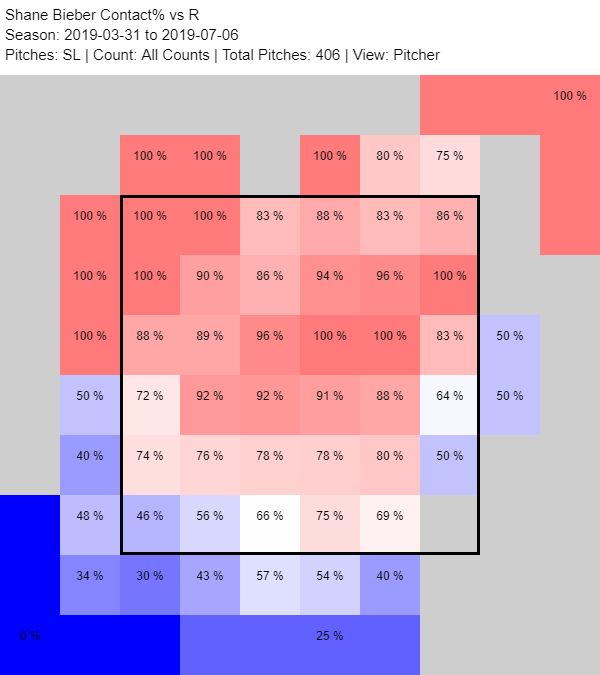
If we’re throwing sliders in the zone, down is good. Away is mostly fine. Down and away, especially out of the zone, is where Bieber wants to be. If he can get hitters to chase, that’s good, but he doesn’t need to spike them. The good news is that, thus far, this has all worked. As I’ve mentioned, this is against weaker competition, but he’s been so dominant that it has to raise some eyebrows. Against righties, Bieber has improved from a .312 xwOBA versus RHB in our first time frame to a .229 xwOBA in his last five games. His true talent level is definitely closer to .312 than .229, but overall, I think Bieber has improved both in approach against righties.
For now, hitters are becoming much more aggressive against his fastball. Thus far, they’ve had a hard time barreling them up, instead hitting them weakly or fouling them off. Until he starts to miss bats without his fastball (which probably means elevating his fastball), it’s difficult to say with certainty that Bieber has taken the next step. At least against righties. The increase in ground balls between the two time periods is nice (30.2% to 75%), but it’s hard to buy into that as a skill for now. (Although, there is a phenomenon in which people are more likely to believe in small gains that players make as opposed to gigantor gains, like Bieber has made here. So while he’s not an elite ground-ball guy with his fastball, maybe some of this is real.)
Approach Versus Lefties
His approach against righties is fine and dandy, but for the most part, it’s just been a few subtle tweaks in pitch mix and location. Against lefties, though, this is where I’m really excited about Bieber. He’s already solid against righties, so he is able to make more substantive gains against lefties since he’s much worse there.
Five games from our first time frame:
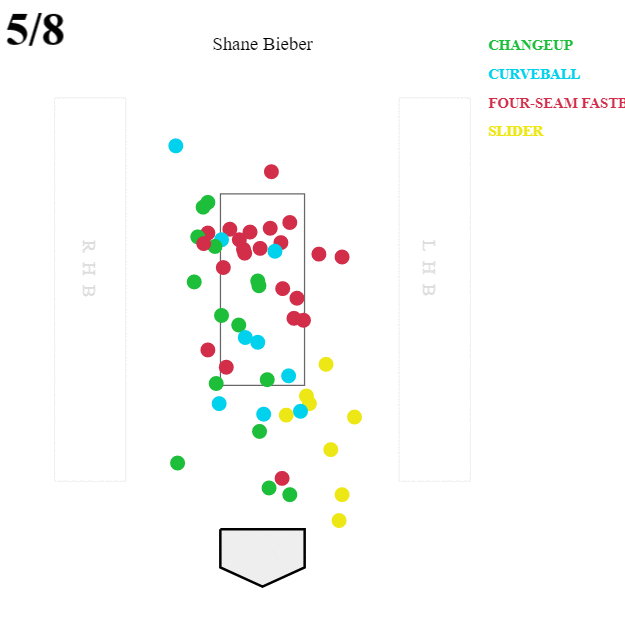
Bieber, in his last five games:
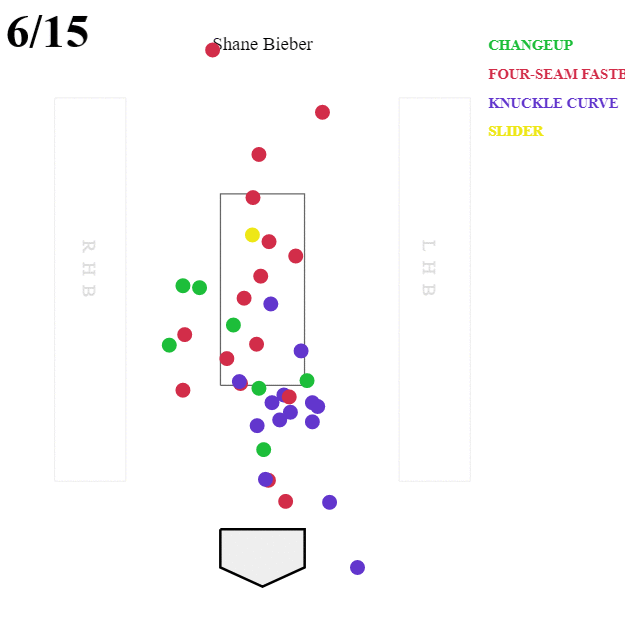
To me, the biggest change is with his curveball—first, he’s seen a large uptick in curveball usage. Not only is he using it more, but he’s also seen about a 7% increase in zone-percentage for his curveball. That makes sense, because if it truly is more deceptive, Bieber should be able to drop it in the zone more for called strikes (and swinging strikes). While his called strike percentage has risen, his swinging-strike percentage has actually lowered. The tradeoff? A nearly equal CSW, and on top of that, his xwoBACON on his curveball has reduced dramatically (.585 to .246), and his weak-percentage has nearly doubled. So, while we should probably not expect this level of weak contact to persist for his curveball, his K-BB% has risen, because he hasn’t walked anyone with his curveball in more than five games. In the meantime, we’ll have to play the waiting games and see how Bieber fares against better hitting teams over time. If this all maintains, we can start to believe in all of this more.
Previously, Bieber had spread his fastball throughout the zone against lefties. In his past five games, he has started to really move his fastball towards the outer edge of the zone.
Before:
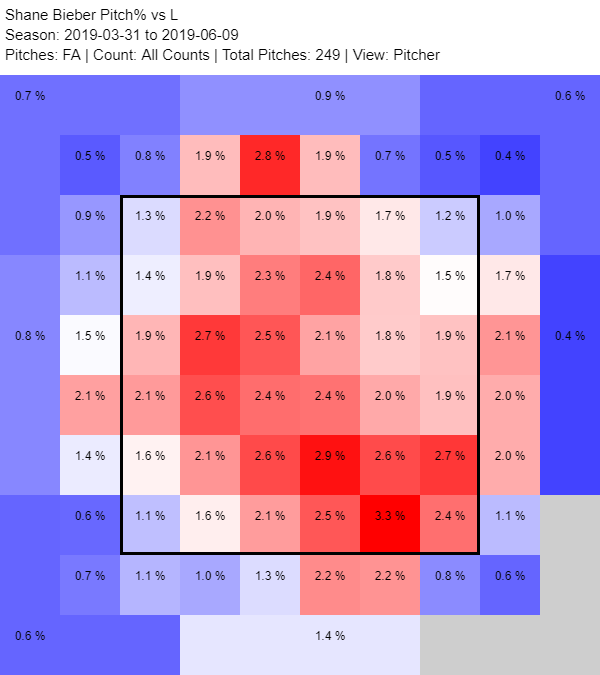
After:
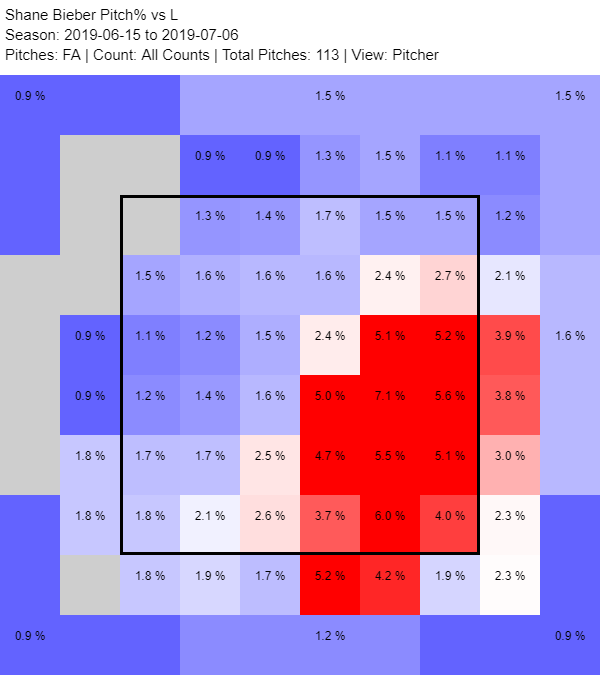
In terms of ISO, the outer edge of the plate was the only area where Bieber wasn’t getting punished—so he’s moved to that area of the zone. It’s simple.
It’s nothing new that Bieber is starting to implement breaking pitches. He’s been doing it all year. What is new is that lefties hold less of an edge as they did before, because he’s started to work his curveball (a good pitch) in more in favor of his fastball (a not-good pitch). The way I see it, his new curveball will help him to weasel into a less-pronounced platoon split between lefties and righties, and he now has the potential to be a more-nuanced, less-predictable pitcher.
This is an interesting development—Bieber already had a changeup for his fastball, but now he has his curveball which, as I’ve said, is essentially an offspeed derivative of his slider. And so, there’s reason to believe that Bieber can continue to move away from his fastball—which, of his offerings, is most susceptible to getting beaten up—and start toying with letting his curveball play off of his slider. That’s precisely what made Patrick Corbin so good for awhile (although we’re still waiting to see what happens with that). In any case, it’s not crazy to think that his fastball could stand to be serviceable, too. What I would like to see from Bieber is, when he falls behind in the count, that he continues to utilize his breaking stuff. That’s one aspect of his game that is missing. In any case, Shane Bieber changed his curveball, he’s gotten less predictable, and things have started to fall into place. Now if he could just start elevating that damn fastball.
(Photo by Gerry Angus/Icon Sportswire)


Really nice thorough write-up. I will add that he did end up dominating against a tough opponent yesterday. Not to drag controversy into here, but he was even better than the numbers suggest as those two HBP calls that really weren’t really messed with his 7th inning. In reality, he dominated the Twins, and it was great to see.
Not diving in too deep, my general observation was the biggest change is that he’s not pitching near the middle of the plate anywhere near as much as before, which obviously helps him not get knocked around at times like he had in the past. That was also my first time watching him in a while.
Thanks for your feedback! I’d totally agree with that sentiment about avoiding the middle of the plate.
Right before I sent my post in for review, I did see that he had quite a nice game against the Twins, but I decided to leave it out of my analyses since I would have had to wait until today to get all of the data back. Regardless, it was great to see and really backs my claims up, I think.